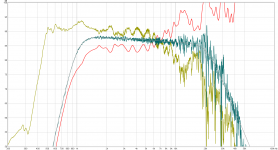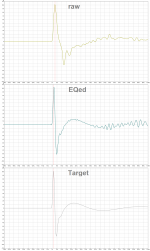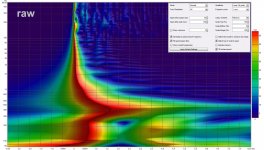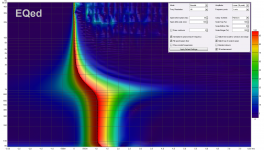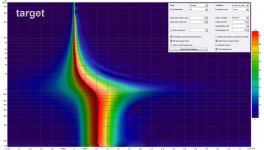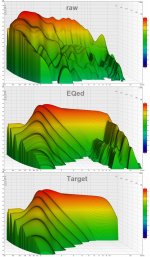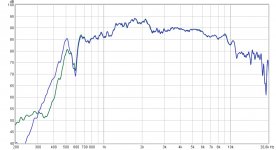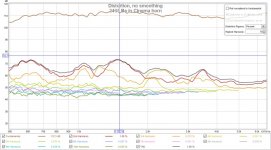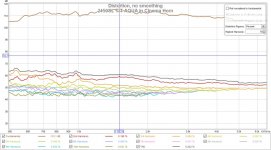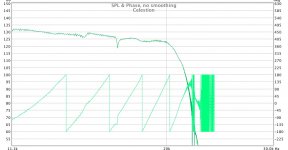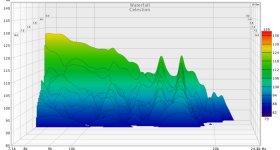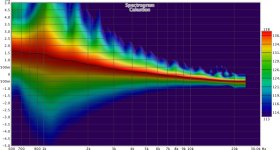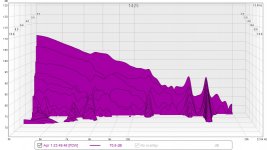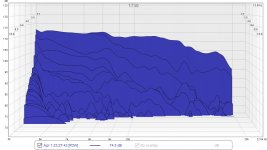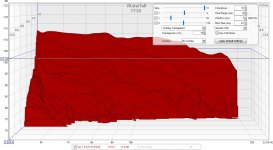But that's not necessarily HOMs. It could be internal reflections of the main mode - which I suspect is the case, not HOMs.
Pretty noisy drivers!! too bad they are in different horns. The comparison probably doesn't mean too much though seeing the radian diaphragm mount is so erratic (bad!) and different horns. I like to look at fh to 5K most with upper mid compression drivers - 5k up is more for treble horns - I find be can settle fast (JBL 2435) but tends to have high high order distortion that gives illusion of "better detail" to some people
... and a slightly noisy comment. Sorry.
Behringer uses an amplitude scale of 20-25dB in their white papers. Here we have 40 dB!
Would some of analysers please produce a different scale for POOH with only 25dB that he can sleep better tonight?
 😀
😀Exercised EQ AL diagraph to a known target passband 8th order LR at 1kHz - 21kHz BW2, comp filtering or reflection in conflict with close microphone or whatever it is is hard to EQ right 😛 and probably some reason for waterfall HF ringing, all graphs below include raw/EQed/synthetic target, failed to get APL_TDA graphs from a loop where EQed wav-file was loaded in convolution engine probably because APL_TDA run 96kHz and convolution file was at double.
Attachments
Exercised EQ AL diagraph to a known target passband 8th order LR at 1kHz - 21kHz BW2, comp filtering or reflection in conflict with close microphone or whatever it is is hard to EQ right 😛 and probably some reason for waterfall HF ringing, all graphs below include raw/EQed/synthetic target, failed to get APL_TDA graphs from a loop where EQed wav-file was loaded in convolution engine probably because APL_TDA run 96kHz and convolution file was at double.
Thanks a lot!
I have done another measurement with a different horn which is similar to Beyma TD385. In this case the microphone is 35cm away from the mouth. Some damping material was on the floor. And the measurement was done with 96kHz 🙄
This horn needs considerable EQ also in the 1k-2k5 region which might be related to the strange looking mouth area. This horn does not show such a deep hole around 12k. Also attached is an impuls export. I have done the measurement with more power (louder) than before. The impedance curve in this horn was already shown earlier.
Attachments
Pretty noisy drivers!! too bad they are in different horns. The comparison probably doesn't mean too much though seeing the radian diaphragm mount is so erratic (bad!) and different horns. ...
Again to this.
I am always open for all kinds or arguments...IF... they are underlined and supported with facts. diagrams can be tuned in many ways let something be looking bad or good with the same base of data.
As already mentioned to support your down-rating there are missing two points:
1. Show something better with comparable measurement setup and we can discuss the results here.
2. Explain why the Radian diaphragm mount is erratic bad.
Thanks!
Attachement 3002.jpg
This analysis looks similar to this here around 12k for aluminium:
http://www.behringer-electric.de/files/lautsprecher/Truextent_Files/TechBrief_SSX%20in%20Radian950.pdf
... last but not least a comparison with closing this small ventilation hole in the back chamber. Doing this should be no problem for small power driving as this hole is intended to increase the life time of the diaphragm. Gives more low frequency amplitude. If a horn loads better to LF than this horn shown here the crossover design may give some different options.
Blue line is vent hole closed.
Blue line is vent hole closed.
Attachments
Can you show us "quiet" drivers using the same plots? Or maybe post the impulse files here so they can be directly compared.
Here'a file .. have fun.
View attachment celestion.zip
I wish to thank everyone who is contributing. Is is good to see data and analyses being shared.
One downside of the measurement I shared above is that my ADC is fairly old and samples at 44.1 Sa/s. Hence there could be some aliasing occurring near 20 kHz. Also, I did not optimise levels nor gain chain so there could be some artifacts way down.
If all goes well a new ADC should be here in a few weeks, and I will redo the measurements at 96 kSa/s, including at louder levels.
Plugging the hole on the driver is a great trick!
Has anyone opened the driver to see what kind of damping material is in the back chamber?
Cheers - Pierre
One downside of the measurement I shared above is that my ADC is fairly old and samples at 44.1 Sa/s. Hence there could be some aliasing occurring near 20 kHz. Also, I did not optimise levels nor gain chain so there could be some artifacts way down.
If all goes well a new ADC should be here in a few weeks, and I will redo the measurements at 96 kSa/s, including at louder levels.
Plugging the hole on the driver is a great trick!
Has anyone opened the driver to see what kind of damping material is in the back chamber?
Cheers - Pierre
Plugging the hole on the driver is a great trick!
Has anyone opened the driver to see what kind of damping material is in the back chamber?
Cheers - Pierre
Yes, no damping inside the back chamber.
Last edited:
I think I sent the celestion cdx - 1730 . CELESTION CDX1-1730 SPECIFICATIONS Pdf Download.
It's soft.
https://www.manualslib.com/manual/221719/Celestion-Cdx1-1730.html
It's soft.
https://www.manualslib.com/manual/221719/Celestion-Cdx1-1730.html
There is quite a change in distortion in those plots, you can't see distortion from imported impulses in REW so that would need to be compared in graphs from those who took the measurements.
Here are some comparison shots of POOH's impulse with the same settings or as close as I could get to the ones I posted before.
The phase is not clean in the celestion measurement like it was in the other so it harder to compare that aspect the Celestion is also a 1" driver and may not be able to be crossed as low as the 745
SPL Phase - Phase is wrapped to make it visible

Waterfall

Spectrogram 5ms

Here are some comparison shots of POOH's impulse with the same settings or as close as I could get to the ones I posted before.
The phase is not clean in the celestion measurement like it was in the other so it harder to compare that aspect the Celestion is also a 1" driver and may not be able to be crossed as low as the 745
SPL Phase - Phase is wrapped to make it visible
Waterfall
Spectrogram 5ms
Attachments
- Home
- Loudspeakers
- Multi-Way
- Beyond the Ariel
